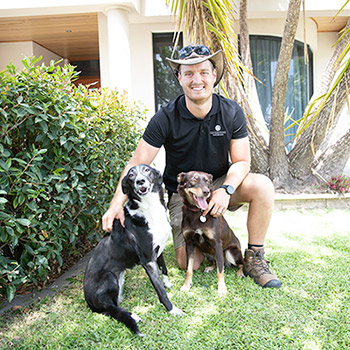
Kangaroo Paw, known formally as Anigozanthos, is a unique and striking plant native to Australia. It is known for its distinctive flowers that resemble the paws of a kangaroo, hence its name. There are tall Kangaroo Paws which flowers can grow up to 2 meters, and short Kangaroo Paws which grow to about 1 meter.
The Kangaroo Paw plant thrives in well-drained soil that is rich in organic matter. It prefers full sun and a warm, dry climate. In areas with hot summers and mild winters, the plant can be grown in the ground. However, in areas with colder winters, the plant should be grown in pots and brought indoors to protect it from frost. (This product is great for helping with frost, best applied before the frost but can also help after or during a cold snap.)
One interesting fact about Kangaroo Paw is that it is a member of the Haemodoraceae family, which means it is related to the common bloodroot and the Western Australian Christmas tree. Additionally, the plant has been used by Indigenous Australians for medicinal purposes, with the roots of some species being used to treat a variety of ailments, including headaches and skin conditions.
In terms of cultivation, Kangaroo Paw is considered easy to grow and maintain. It can be propagated from seed or division of the clumps. They are also drought tolerant and don’t require frequent watering.
In summary, Kangaroo Paw (Anigozanthos) is a unique and striking plant native to Australia with 11 different varieties. It thrives in well-drained soil that is rich in organic matter and prefers full sun and a warm, dry climate. It has been used for medicinal purposes by Indigenous Australians and is considered easy to grow and maintain.
Three beautiful and different options
Anigozanthos flavidus Red
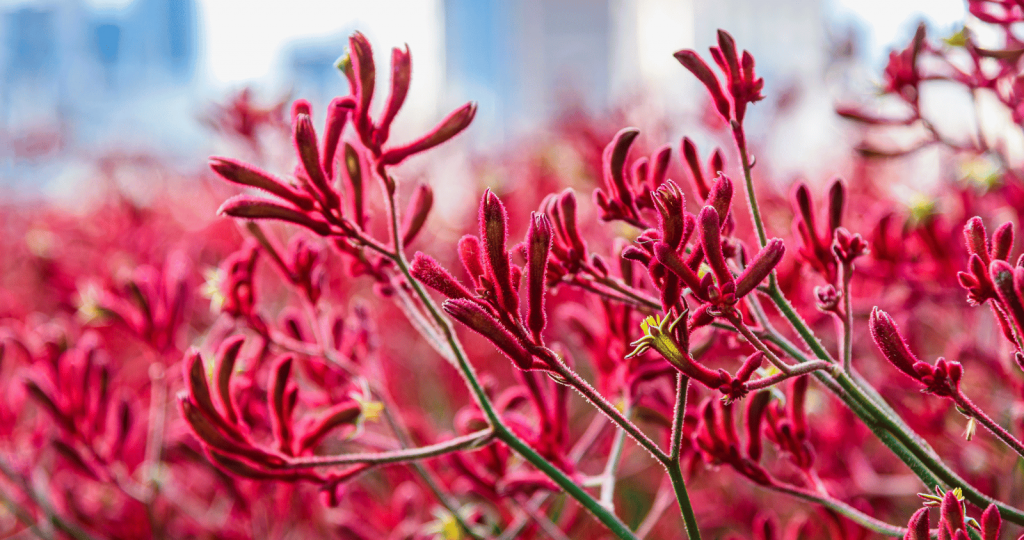
Anigozanthos flavidus ‘Red’ is known for its bright red flowers that bloom in the spring and summer. The leafy part of the plant typically grows to a height of 60-90 cm with a width of 40-60 cm but the flowers can grow up to 2 meters high
It prefers full sun and well-drained soil, making it an ideal option for gardens in regions with hot summers and mild winters. It is drought-tolerant and low-maintenance, making it a great choice for gardeners who want a striking and easy-to-care-for plant.
The red color of the flowers make it an attractive option for a garden, adding a bright and bold pop of color. The flowers are long-lasting and can be cut and used in floral arrangements. The foliage is also attractive, with long, slender, green leaves that are slightly curved.
Anigozanthos flavidus ‘Red’ is a hardy and versatile plant, it can be grown in pots, rock gardens, or as a feature plant in a garden bed. It’s perfect for adding color and texture to a garden, and it’s easy-care nature makes it a great choice for both experienced and novice gardeners. For more information about this plant, click here.
Anigozanthos Bush Zest
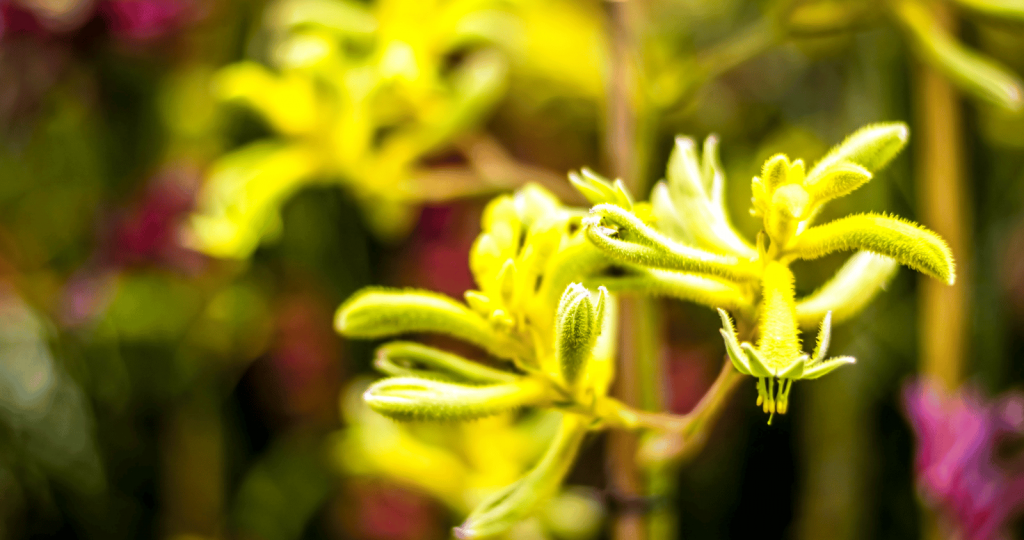
Anigozanthos Bush Zest is a variety of Kangaroo Paw, also known as “Bush Zest” or “Bush Anigozanthos”. It is known for its bright yellow-green flowers that bloom in the late spring and summer. The flowers are shaped like a paw and are held on tall, green stems that rise above the foliage. The plant typically grows to a height and width of around 50 cm but the flowers often grow around 1-1.2 meters high.
It prefers full sun and well-drained soil, making it an ideal option for gardens in regions with hot summers and mild winters. It is drought-tolerant and low-maintenance, making it a great choice for gardeners who want a striking and easy-to-care-for plant.
The yellow-green colour of the flowers make it an attractive option for a garden, adding a bright and bold pop of colour. The foliage of the plant is also attractive with long, slender, green leaves that are slightly curved. For more information about this plant, click here.
Anigozanthos Bush Diamond
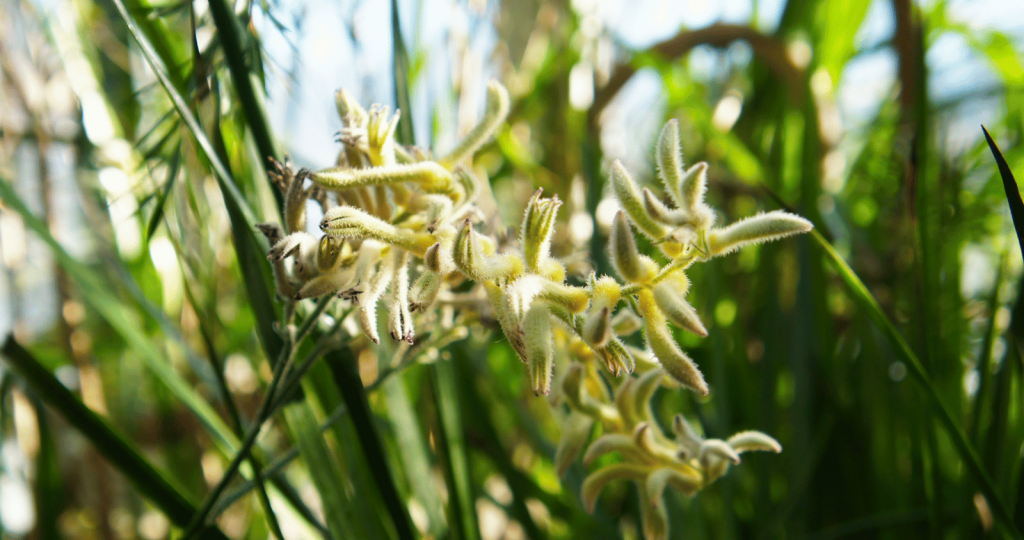
Anigozanthos Bush Diamond is known for its striking white flowers with pink overtones. The plant typically grows to a height and width of 50-60 cm, it is a compact plant and flowers do not grow much higher than the plant unlike some other varieties of Kangaroo Paws.
It prefers full sun and well-drained soil, making it an ideal option for gardens in regions with hot summers and mild winters. It is drought-tolerant and low-maintenance, making it a great choice for gardeners who want a striking and easy-to-care-for plant.
‘Bush Diamond’ does very well in pots and containers and is well suited to coastal region. It is also a great plant for attracting bees, butterflies and nectar loving birds. For more information about this plant, click here.
Are Kangaroo Paw drought tolerant?
Yes, Kangaroo Paws are considered drought-tolerant plants. They are native to the arid regions of Western Australia, where they have adapted to survive in conditions of low rainfall and high heat. They have deep roots that allow them to access water stored deep in the soil, and their leaves are covered in a thick, waxy coating that helps to conserve moisture.
How much water do Kangaroo Paw need each week ?
Once established Kangaroo Paws typically require between 10-20mm of water per week, depending on the weather conditions and the stage of growth. During hot, dry weather, they may require more water to keep them hydrated. In general, it is best to water Kangaroo Paws deeply, allowing the water to penetrate the soil to the roots. Over watering can cause the roots to rot, so it is important to let the soil dry out slightly between watering.
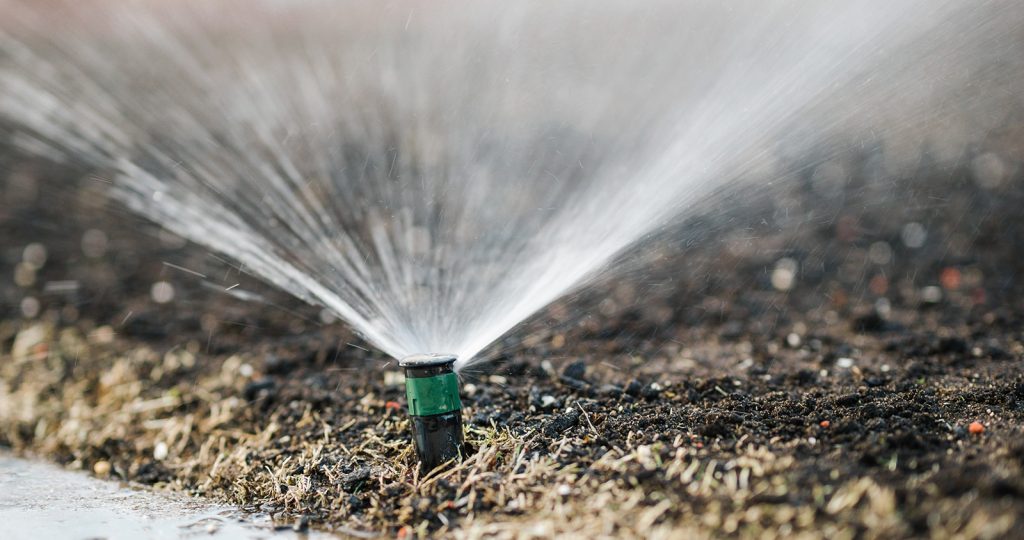
When is the best time of year to prune Kangaroo Paws?
Kangaroo Paw The best time of year to prune Kangaroo Paws is after the flowering season, typically during the late summer or early Autumn. This allows the plant to focus its energy on producing new growth and preparing for the next flowering season. Pruning at this time of year also removes any dead or damaged foliage, allowing the plant to conserve energy and resources. It’s best to avoid pruning in the middle of summer, since the plant needs it’s foliage to survive the heat.
How to prune a Kangaroo Paw
Firstly put on gloves and long sleeves and wear glasses as some people can be allergic to the little hairs on Kangaroo Paw flowers and stems, it can be very irritating even if you are not allergic.
- Cut back dead or damaged leaves and stems with secateurs: Remove any leaves or stems that are dead, diseased, or damaged. This will help to improve the overall appearance of the plant and prevent the spread of disease. (If you are looking for some high-quality secateurs, here are two great options depending on your budget: option 1 and option 2.)
- Cut back old flower stalks right to the base with secateurs: After the blooming period is over, the flower stalks will turn brown and die back. Cut these stalks back to the base of the plant to encourage new growth.
- Cut back the plant to size with a hedge trimmer or sheers: Cut back the plant to the desired size. You can cut it right down to 10-20cm if the plant is well established. For younger plants that are still thin and around 30cm in height you can leave out this final step until next season.
- Clean up the area: Remove any dead leaves or stems that have fallen to the ground and dispose of them to prevent the spread of disease.
It’s important to note that pruning Kangaroo Paws can be done at any time of the year, but the best time to prune is after they have flowered.
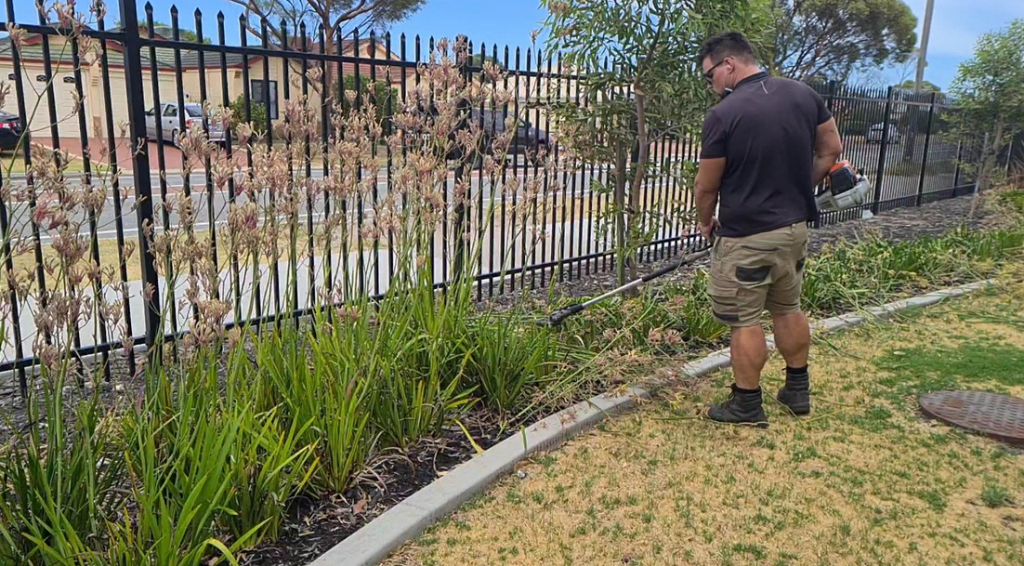
How quickly do Kangaroo Paw grow to their full height?
It usually will take a couple of years for a Kangaroo Paw to get to full height. In ideal conditions, with plenty of sunlight and well-drained soil, Kangaroo Paws can grow rapidly. The rate of growth will also depend on the age of the plant and how it is being cared for.
Should Kangaroo Paw be fertilised?
Yes, Kangaroo Paws benefit from quality fertilisers to promote healthy growth and encourage the production of new flowers. Fertilising helps to provide the plants with the necessary nutrients, especially during the growing and blooming seasons.
What fertiliser is best for kangaroo paw?
The best fertilisers for Kangaroo Paws are slow-release, balanced fertilisers, designed for Australian natives. “Bush Tucker” by Neutrog is a great option.
How do you apply fertiliser to a kangaroo paw?
Kangaroo Paw Fertiliser should be applied to the soil around the base of the Kangaroo Paw, being careful not to get it on the leaves or stems of the plant. Watering the fertiliser into the soil after application will help it to reach the roots and get to work. Adding a wetting agent will also help water, and thus the fertiliser, penetrate the soil and get down to the roots.
How often should kangaroo paw be fertilised?
It depends on your goal. To maintain a healthy plans a single annual fertilisation in spring with a complete slow release fertiliser will be all that is needed.
If you are trying to encourage quick growth then fertilise every 6-10 weeks during the growing season. It is important to follow the manufacturer’s instructions for the specific fertiliser you are using, as well as testing the soil to determine the specific needs of your plants.
What pests are common with Kangaroo Paw?
Common pests that can affect Kangaroo Paws include:
- Aphids: These small, pear-shaped insects can be found on the leaves and stems of Kangaroo Paws, where they suck sap and can cause leaf distortion.
- Woolybear Catapillar: Woollybear caterpillars (the larvae of the tiger moth) can cause damage to Kangaroo Paw plants by consuming the leaves and flower buds. These caterpillars are covered in dense, silky hairs, which give them a fuzzy appearance. They can be a serious pest for Kangaroo Paw plants, especially when they occur in large numbers.
- Snails and slugs: Snails and slugs can cause damage to Kangaroo Paw plants by consuming the leaves and flower buds. These pests are known for their voracious appetite and can quickly defoliate a plant if left unchecked.
It is important to keep an eye out for signs of pests, such as leaf distortion, discoloration, or sticky residue on leaves, and to take action as soon as possible to prevent the pests from becoming a problem. It’s best to check with a local nursery or gardening expert for the best ways to deal with pests in your area as different regions have different pests.
What diseases are common with Kangaroo Paw?
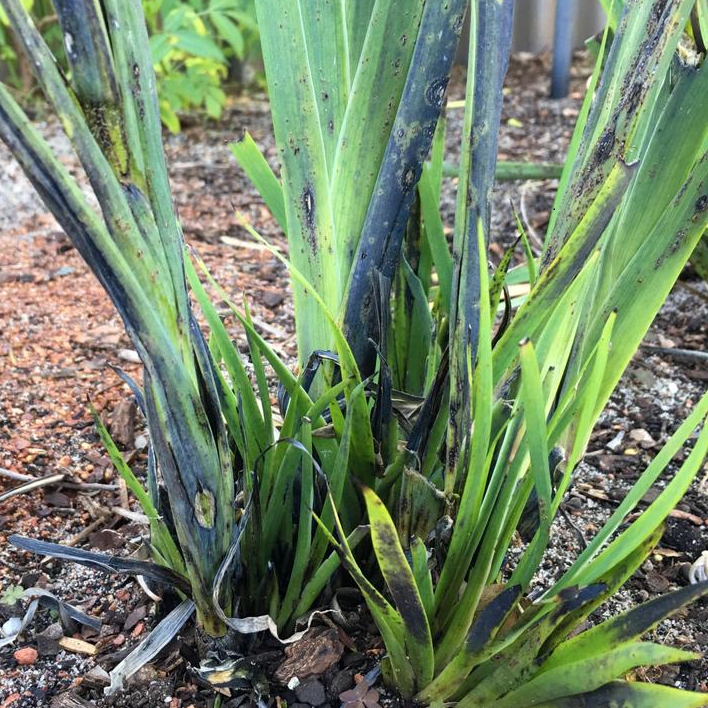
Common diseases that can affect Kangaroo Paws include:
- Black Ink Spot Disease: is caused by a variety of fungi and causes the leaves of kangaroo paws to turn black.
- Root rot: This disease is caused by over-watering or poor drainage and can cause the roots of Kangaroo Paws to become waterlogged and rot. The plants may become stunted or die.
- Rust: This disease is caused by a fungus and can cause small, orange or yellow spots on the leaves of Kangaroo Paws. The spots may be raised and can cause the leaves to become distorted or discolored.
It’s best to check with a local nursery or gardening expert for the best ways to deal with diseases in your area as different regions have different diseases. It is important to prevent diseases by ensuring your Kangaroo Paw is grown in well-draining soil, in an area with good air circulation, and to avoid over-watering, overcrowding, and to keep the area clean.
Why do Kangaroo Paw leaves turn black?
Kangaroo Paw leaves turning black is most often a disease called Black ink spot disease. We have written a whole article about this here.
Is kangaroo paw poisonous to dogs?
Kangaroo Paws are considered to be non-toxic to dogs. However, it’s always best to keep an eye on your dog when they are near any plants, as some dogs may have an allergic reaction or may have individual sensitivities. If your dog ingests a large amount of Kangaroo Paw and shows symptoms such as vomiting, diarrhea, or lethargy, it’s best to contact your veterinarian for advice.
It’s important to note that even though a plant may be considered non-toxic, it doesn’t mean it’s safe for consumption by dogs, or even humans. It is best to always keep plants out of reach of pets and children to prevent accidental ingestion.
How long do Kangaroo Paws live for?
In ideal conditions, an individual Kangaroo Paws can live for up to 5-6 years. As Kangaroo Paws reproduce by division the plant would have reproduced before it dies so a reproducing cluster of Kangaroo Paws can live on indefinitely. Their lifespan can vary depending on the species, growing conditions, and maintenance practices.
Do kangaroo paws attract bees?

Yes, Kangaroo Paws are highly attractive to bees, butterflies, and other pollinators due to their bright colours and the nectar they produce. The flowers have a unique shape and texture that makes it easy for bees to access the nectar.
These plants are native to Australia, so the pollinators that are naturally attracted to them are native bees and insects. They are also known for being good for hummingbirds, as well as other nectar-loving birds.
If you’re looking to create a bee-friendly garden, Kangaroo Paws can be a great addition, as they are known to provide a reliable source of nectar for bees and other pollinators.
Do Kangaroo Paws attract birds?

Yes, Kangaroo Paws can attract birds. These plants are known for their brightly coloured flowers and unique shape, which can be attractive to nectar-loving birds such as hummingbirds, honeyeaters and some parrots.
The flowers of Kangaroo Paws produce nectar that can be a valuable food source for birds, especially during the dry season when other nectar sources are scarce. Also, Kangaroo Paws can provide a good shelter for small birds and insects.
Do kangaroo paws have invasive roots?
No, Kangaroo Paws typically have a clumping growth habit and generally do not have invasive roots. They typically form a clump of leaves and flowers that spreads slowly over time, but their roots are relatively contained.
It’s important to note that kangaroo paws can be propagated from divisions or from seed. When planted from seed or if not contained, they can grow into a large clump that might need to be divided to prevent over crowding.




